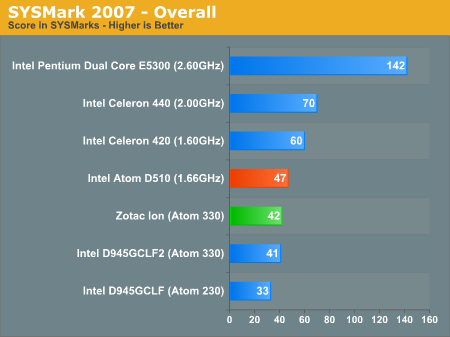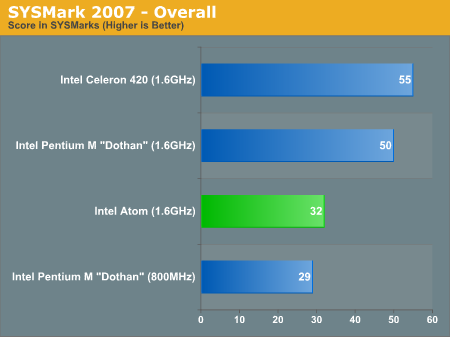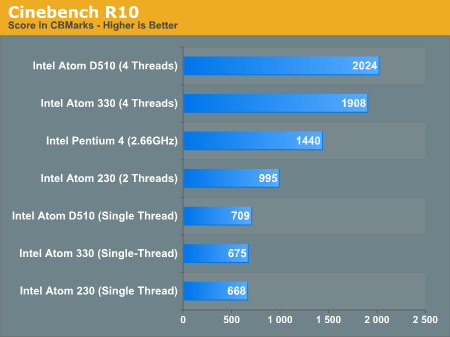Intel Atom D510: Pine Trail Boosts Performance, Cuts Power
by Anand Lal Shimpi on December 21, 2009 12:01 AM EST- Posted in
- CPUs
Performance
Across the board, thanks entirely to the integrated memory controller, Pine Trail is roughly 5 - 10% faster than the original Atom platform. The performance gain varies, but on average I’d say 5 - 10% is a reasonable expectation. It’s lower than I expected, but it looks like Atom’s performance is gated in more areas than just memory operations.

The integrated GMA 3150 feels like it handles Windows Aero a bit worse than Ion at higher resolutions, but I hear that may be a driver issue.
That 5 - 10% performance advantage does actually translate into something you can feel in real world usage. My Pine Trail system felt snappier than my older Atom machines. By no means was it fast, Atom is still slow after all, integrated memory controller or not.
Remember the comparison I did back in 2008:

At 1.6GHz the old single core Atom delivered the performance of roughly a 1.2GHz Pentium M. Thanks to the integrated memory controller I’d put the new Atom D410 at about the speed of a 1.4GHz Pentium M. The dual-core D510 is a bit more difficult to quantify. In single threaded use cases, the D510 still fits the bill as a 1.4GHz Pentium M, move to multithreaded and it’ll clearly have an advantage there.
Interacting with your PC, opening windows, launching apps, browsing the web, is generally all bound by the performance of a single thread. In those cases, you’re still looking at a platform that’s the equivalent of a low end notebook (not desktop) from 2004.

Atom has single threaded performance worse than a Pentium 4, but multithreaded FP/SSE performance can be much better on the dual core versions
The second core helps Atom not feel so slow when you’re trying to do two things at once. The second task doesn’t even have to be that CPU intensive, it could be something as simple as reading a document while you’re launching another application or opening another web page. Even in light multitasking, the second core helps.
On average, it’s still a sluggish platform. I’d take Pine Trail over the old Atom any day, but set your expectations accordingly: Atom can’t deliver the performance of a modern day machine, it’s best used as a secondary or tertiary PC.
Test Configuration
| Motherboard: | Intel D945GCLF2 (Atom 330) Intel D945GCLF (Atom 230) Intel D510MOB (Atom D510) Zotac Ion (Atom 330) |
| Chipset Drivers: | Intel 9.1.1.1011 (Intel) |
| Hard Disk: | Intel X25-M SSD (80GB) |
| Memory: | G.Skill DDR2-800 2 x 2GB (4-4-4-12) 2GB for the two Intel Atom 330/230 boards |
| Desktop Resolution: | 1920 x 1200 |
| OS: | Windows Vista Ultimate 32-bit (for SYSMark) Windows Vista Ultimate 64-bit |










41 Comments
View All Comments
yuhong - Wednesday, December 30, 2009 - link
"Granted the board only costs $75 new, but would it have killed Intel to include DVI or HDMI out?"That is a limitation of the on-die GPU, it only support VGA and LVDS for the display.
lucaiuli - Saturday, January 2, 2010 - link
Found this board at http://www.mini-box.com/D510MO-mini-ITX-Intel">http://www.mini-box.com/D510MO-mini-ITX-Intel, it will be available this week, price is not bad. I am considering buying one and with a Broadcom Crystal HD miniPCI Express card and proper miniITX enclosure it would be a nice fanless and siled HD HTPC for my living room.geok1ng - Tuesday, December 22, 2009 - link
"It’s not a problem in areas where AMD is competitive, but what about areas in which they’re not?"AMD chose not to be competitive on the Netbook and lower power notebook market. There was a time when ATIs IGPs were very good, and today an overclocked 3200 can dish out enough fps to compete with NVIDIAs offerings. AMD had a lower power CPU months before the CLUVs, but it never become an integrated platform like Ion, even on the micro HTPC market.
If a company has a super IGP, and there was a time when AMD had one, and the market has a new wave of low power low costs Netbooks, and this company decides not to join the wave, well, dont blame Intel when things go the way of the Dodo.
I am only seeing Intel paying AMD so that Intel remains dominating the market, even on produtcs were Intel's offerings are so crappy as the IGP market.
Penti - Tuesday, December 22, 2009 - link
AMD still offers the AMD Neo X2 with AMD 785G or HD4200 graphics or with embedded AMD 780E + SB710 chipset. But that's not a netbook offering but a consumer or ultra-portable low-power notebook offer. I don't really like it that it's K8 based but it's still not totally bad. I don't think AMD is interested in the MID/smartphone market Intel is going after slowly any way.There's reason the AMD Neo platform didn't become a HTPC platform, first it was only released with 690E, secondly it wasn't supported in XBMC on linux. Then there's cost. Now CULV makes a lot more sense. GMA4500 is good enough. And it's first now supports really is coming through with Flash acceleration etc. It was a very limited usability with such a platform before. So soon Atom (with Broadcom accelerator), CULV etc really becomes useful and functional in the consumer space. AMD don't have any advantages even if they have support for the same things. I think it's wise that they are designing wholly new mobile products. Then there's gonna be a fair fight. Products will have a lower power envelope and be cheaper and on newer node. More will be released into the market.
killerclick - Monday, December 21, 2009 - link
This could be a chance for VIA Nano to get in on the netbook market. I fear however that most people buying netbooks won't know or care about the difference between the platforms. If it's cheap and can at least play 720p they won't go out of their way to get something non-Intel.Penti - Tuesday, December 22, 2009 - link
I won't consider the Nano until they have shrunk it, made it less power hungry, made it dual core and released a good graphics chip with truly open source drivers. I'd rather have Pineview + Broadcom BCM70015 if not.It's impressive what Centaur can do with ~100 employees, but I'm not impressed with the S3 Graphics or VIA chipset team.
killerclick - Tuesday, December 22, 2009 - link
I meant Nano + ATI/NVIDIA IGPPenti - Tuesday, December 22, 2009 - link
Yeah I know you wrote that. But..That will never happen. It's Nano + Mobile ATI/NVIDIA GPU tops. But I don't see the point. Via's own gpus are fine for DXVA in Windows etc. Nano aren't that power efficient to begin with. It's not like such platforms will be fast enough to game on either way.
This is what they have coming out (chipset with IGP) http://via.com.tw/en/products/chipsets/v-series/vn...">http://via.com.tw/en/products/chipsets/v-series/vn... It's not that bad. It has modern integrated graphics but it can be used with a discrete graphics solution too.
strikeback03 - Monday, December 21, 2009 - link
If I remember correctly, you used a standard ATX power supply for testing the LF/LF2 Atom boards, which you speculated was part of the reason for such high power consumption. Did you restest with the same PSU as from the Pine Trail system?Griswold - Monday, December 21, 2009 - link
Almost no performance gains - the opposite is actually true with the demise of useful chipset graphics for the atom platform.Buh bye, atom! Hello VIA Nano + ION!